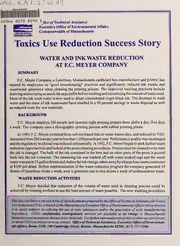
Water and ink waste reduction at F.C. Meyer Company PDF
Preview Water and ink waste reduction at F.C. Meyer Company
l^^W M&S< feA ^1 lEDbb DE7D fiOTE s fice ofTechnicalAssistance Executive Office ofEnvironmental Affairs Commonwealth ofMassachusetts MBCUTIVIOWCtoj tNVMONMtNUlAjWgl Use Reduction Success Story Toxics WATER AND INK WASTE REDUCTION MEYER COMPANY AT EC. SUMMARY F.C. Meyer Company, a Lawrence, Massachusetts cardboard box manufacturer and printer, has trained its employees in "good housekeeping" practices and significantly reduced ink wastes and wastewater generated when cleaning the printing presses. The improved washing practices include drainingandscrapingasmuchinkaspossiblebeforewashingandminimizingtheamountofwaterused. Most ofthe ink wash water is now used to dilute concentrated virgin black ink. The decrease in wash water and the reuse ofink wastewater have resulted in a 90 percent savings in waste disposal as well as reduced costs for raw materials. BACKGROUND F.C. Meyer employs 200 people and operates eight printing presses three shifts a day, five days a week. The company uses a flexographic printing process with rubber printing plates. VOC In 1989, F.C. Meyer switched from solvent-based inks to water-based inks, and reduced its emissionsfrom280tonsperyeartolessthan 1,000poundsperyear. Performancequalitywasunchanged andtheregulatoryworkloadwasreduced substantially. In 1992., F.C.Meyerbeganto seekfurtherwaste reductionopportunities andlookedatthepresscleaningprocedures. Pressesmustbecleanedeverytime the ink is changed. The bulk ofthe ink contained in the bins and on other parts ofthe press is poured back into the ink container. The remaining ink was washed offwith water-soaked rags and the waste waterwasputin55 gallondrumsand,beforetheinkchange,takenawaybyahazardouswastecontractor at $100 per drum. Before implementation ofthe waste reduction program the company generated 10 drums ofhazardous waste a week, now it generates one to two drums a week ofnonhazardous waste. WASTE REDUCTION ACTIVITIES F.C. Meyer decided that reduction of the volume of water used in cleaning process could be achieved by training workers to use the least amount ofwaterpossible. The new washing procedures ThisSuccessStoryisoneofaseriesofsuchdocumentspreparedbytheOfficeofTechnicalAssistanceforToxics UseReduction(OTA), a branch oftheMassachusettsExecutiveOfficeofEnvironmentalAffairswhosemission is to assist industry in reducing the use oftoxic substances and/or the generation oftoxic manufacturing byproducts. OTAs confidential, nonregulatory services are available at no charge to Massachusetts businessesandinstitutionsthatusetoxicchemicals. Forfurtherinformationaboutthisorothersuccessstories, oraboutOTA'stechnicalservices, contact: OfficeofTechnicalAssistance, ExecutiveOfficeofEnvironmen- talAffairs, Room 2109, 100 CambridgeStreet, Boston, Massachusetts 02202, (617) 727-3260. include draining as much ink as possible back into the containers and thorough scraping ofexcess ink offthe press parts before any water is added, and then using as little water as possible. In addition to reducing the volume ofwash waterused, the company asked its supplier to deliver blackinkwith 10%reducedwatercontent. Wastewaterisaddedtotheblackinkwithnoapparenteffect onthecolorqualityoftheink. Thewastewatercanalsobeaddedto othercolors, suchasgrey, insmaller amounts than when added to black ink. Reductions Achieved: Modifying the press cleanup procedure reduced the solids in spent washwater from more than 30 percent to 13 percent. The volume ofwater used also has decreased by 35 percent. Approximately one pint ofwater is now used each time a press is washed. By reusing most ofthe washwater, the amount ofwaste which had to be disposed has decreased from ten to one to two 55-gallon drums per week. Economics: The 55 gallondrumsofwastecostapproximately$100eachtodispose.Implementing thereuseofinkwastewaterhasreducedtheyearlycostofwaste disposal fromabout $52,000 to $5,200.
